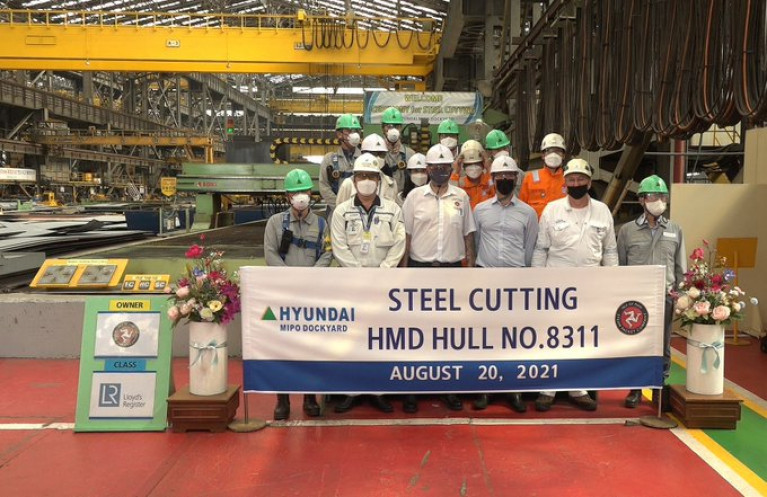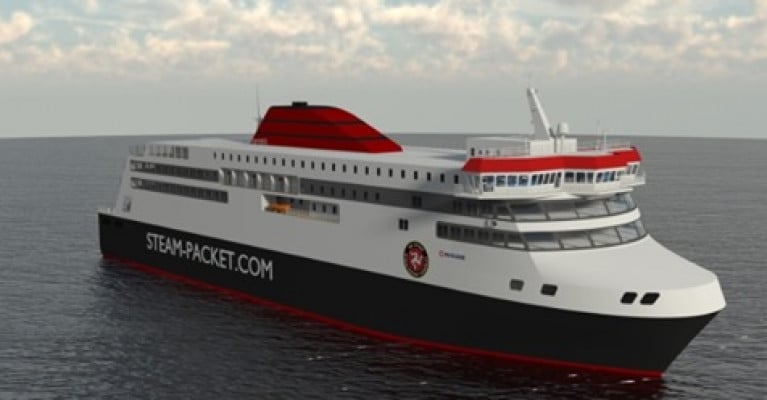Displaying items by tag: South Korean shipyard
Construction of Manxman has begun at the Hyundai Mipo Dockyard in South Korea with the vessel to become the new flagship ferry for the Isle of Man Steam Packet Company.
The first steel cut for the 133m-long Manxman took place yesterday at the Asian shipyard contracted to build the ferry which is due to replace Ben-my-Chree when the ro-pax enters service in 2023.
The new ferry will be able to carry 949 passengers and 495m2 of additional space for freight and vehicles.
Attending the steel cutting ceremony in Ulsan were officials from the Steam Packet Co, Hyundai Mipo Dockyard, Sea Quest Marine Project Management (specialist shipbuilding consultants), Houlder Naval Architects and Lloyds Register (Class Surveyor).
At the milestone event to cut the steel involved a formal pushing of the button to mark the first piece of steel being cut. The event signified the detail design of the vessel comprising a total of around 300 detailed plans. This was finalised and agreed by the Steam Packet's Project Team for construction to commence.
Plasma files are produced from the approved construction drawings to allow the shipyard’s plate cutting machines to automatically and accurately cut each piece of the vessel. There will be up to two months of plate cutting, panel production, plate bending and pipe production before block construction, and then keel laying, can commence.
Isle of Man Steam Packet Company Managing Director Brian Thomson said: ‘The steel cutting ceremony is a milestone occasion and cause for celebration which signifies that after years of planning, the construction of Manxman is under way. The Project Team has been working incredibly hard to ensure the project stays on track and it’s fantastic to see everything progressing as scheduled.
‘This is a very exciting time for the Company and we’re looking forward to keeping the Island community up-to-date with the progress of Manxman ahead of her coming into service, scheduled for spring 2023.’
Shipbuilders in Asia are to custom-build a ferry for the Isle of Man Steam Packet Company at a facility in South Korea with the newbuild due to enter Irish Sea service in 2023.
The agreement was officially confirmed yesterday by the Manx operator's Board of Directors, having signed a contract with one of the world’s major shipbuilders, Hyundai Mipo Dockyard (HMD), based in Ulsan.
It follows a week-long visit to Korea by senior personnel from the IOMSPCo, during which they visited the shipyard where the vessel will be built, viewed a recently completed ship to assess the standard of work and discussed technical and commercial considerations with HMD executives.
Work on physically constructing a replacement for the conventional ferry, Ben-my-Chree, is now due to start in mid-2021 after detailed plans are finalised and agreed between builder and buyer.
The process began last autumn when the Company commissioned a tender exercise, during which a large number of shipyards around the world expressed an interest in building the bespoke vessel.
Isle of Man Steam Packet Company Chief Executive Mark Woodward said: ‘For some time we have been conducting detailed analysis as we develop plans for major investment in our fleet. ‘I am delighted to confirm that, following lengthy discussions with a leading shipyard in South Korea, we have confirmed specifications for the vessel and today signed a contract with Hyundai Mipo Dockyard.
‘This truly is an exciting time in our history and, in the year we marked our 190th anniversary, the new vessel will take the Isle of Man Steam Packet Company forward to our 200th anniversary and beyond.’
The new vessel, expected to commence service in Spring 2023, will be an important part of the Company’s future plans, bringing high levels of on-board facilities and enhanced freight capability.
The Company is also committed to maintaining a third back-up vessel, intended to be the Ben-my-Chree when the new vessel arrives, to enhance security of both passenger and freight links and also help increase capacity during the TT and Classic TT.
Mr Woodward continued: ‘The final specification and build programme is still in development but it is expected the new vessel will be slightly larger than the Ben-my-Chree in most respects but with considerably more passenger space. It is also intended to be more environmentally efficient and manoeuvrable in poor conditions.
‘Factoring in various technical and logistical considerations for a new vessel, and taking into account the recent public consultation exercise where possible, our aim for when we introduce the new addition is to ensure we provide an even higher level of service to the Island community and our customers.’






























































